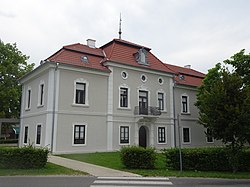Kidričevo
Kidričevo | |
|---|---|
 Kidričevo Mansion | |
|
Styria | |
| Statistical region | Drava |
| Municipality | Kidričevo |
| Area | |
| • Total | 7.10 km2 (2.74 sq mi) |
| Elevation | 238.5 m (782.5 ft) |
| Population (2012) | |
| • Total | 1,257 |
| [1] | |
Kidričevo (pronounced
Name
The historical settlement that the town was built around was called Strnišče. In 1947,[4] this was renamed Kidričevo after Boris Kidrič,[5] a leading Slovenian communist and one of the chief organizers of the Partisan movement in Slovenia from 1941 to 1945. In 1974, territory was separated from the settlements of Kidričevo and Župečja Vas to create the current settlement of Strnišče.[4][6]
Sterntal Concentration Camp
The
Mass graves
Kidričevo is the site of two mass graves connected with the Sterntal Concentration Camp. The Sterntal 1 Mass Grave (Slovene: Grobišče Sterntal 1) was uncovered in the 1980s during excavation work at the Talum factory. The remains were removed and disposed of in an undocumented manner. The grave is located in a meadow behind the factory.[16] The Sterntal 2 Mass Grave (Grobišče Sterntal 2) contains the bodies of prisoners from the Sterntal concentration camp. It is located in a pine grove opposite the entrance to the former camp, about 50 meters (160 ft) from the road.[17]
References
- ^ Statistical Office of the Republic of Slovenia
- ^ Kidričevo municipal site
- ^ Slovenian Ministry of Culture register of national heritage reference number ešd 22209
- ^ a b c d Savnik, Roman, ed. 1980. Krajevni leksikon Slovenije, vol. 4. Ljubljana: Državna založba Slovenije. p. 401.
- ^ Snoj, Marko. 2009. Etimološki slovar slovenskih zemljepisnih imen. Ljubljana: Modrijan and Založba ZRC, p. 188.
- ^ Statistical Office of the Republic of Slovenia. Strnišče (in Slovene)
- ^ Milko Mikola (2008). "Communist Concentration Camps and Labor Camps in Slovenia". In Jambrek, Peter (ed.). Crimes Committed by Totalitarian Regimes (PDF). Brussels: Slovenian Presidency of the Council of the European Union. p. 150. Archived from the original (PDF) on March 4, 2016. Retrieved May 23, 2019.
- ^ a b Mikola, Milko. 2008. "Concentration and Labour Camps in Slovenia." In: Peter Jambrek (ed.), Crimes Committed by Totalitarian Regimes, pp. 145–154. Ljubljana: Slovenian Presidency of the Council of the European Union, p. 147. Archived 2012-01-17 at the Wayback Machine
- ^ Conze, Werner, & Hartmut Boockmann. 2002. Deutsche Geschichte im Osten Europas, vol. 7. Munich: Siedler, p. 419.
- ^ Šamšerl, Janez. 2012. "O sveti križ, življenja luč, o sveti križ, nebeški ključ!" Družina (4 March).
- ^ Otterstädt, Herbert. 1962. Gottschee: verlorene Heimat deutscher Waldbauern. Freilassing: Pannonia-Verlag, p. 52.
- ^ Hochberger, Ernst, et al. 1994. Die Deutschen zwischen Karpaten und Krain (= Studienreihe der Stiftung Ostdeutscher Kulturrat, vol. 4). Munich: Langen Müller, p. 132.
- ^ Topolovec, Rajko. 2008. "Živečim svojcem in drugim narodom bi se morali iskreno opravičiti." Večer (18 January).
- ^ Leidensweg der Deutschen im kommunistischen Jugoslawien, vol. 1: Ortsberichte. 1991. Munich: Bundesverband der Landsmannschaft der Donauschwaben, p. 866.
- ^ Krainer, Hans. Die Partisanen in Krain, das Ende des Krainer Deutschtums, 1941-1945.
- ^ Ferenc, Mitja (December 2009). "Grobišče Sterntal 1". Geopedia (in Slovenian). Ljubljana: Služba za vojna grobišča, Ministrstvo za delo, družino in socialne zadeve. Retrieved November 22, 2023.
- ^ Ferenc, Mitja (December 2009). "Grobišče Sterntal 2". Geopedia (in Slovenian). Ljubljana: Služba za vojna grobišča, Ministrstvo za delo, družino in socialne zadeve. Retrieved November 23, 2023.
External links
- Kidričevo on Geopedia
- Kidričevo municipal site (in Slovene)
- Talum Company (in Slovene)

